From Rankings to Discoverability: The New SEO Playbook
SEO has changed, and so should your strategy. This playbook will show you how to build content that’s discoverable, trusted, and shared across channels.

Let’s be real: content marketing and SEO have gotten wild lately.
I spent the last year battling traffic drops, updating content every few weeks, talking with the SEO team every day, and eventually looking for new ways to attract users.
Chances are, you’ve been there too.
But here’s the truth: I don’t think that SEO is dead. What’s actually dying is the old playbook.
It’s time for a new strategy. One that fuses SEO with brand building, user-first content experience, and content discoverability.
While most folks are fixated on what’s not working, let’s talk about what is. And how to adapt.
First things first: What’s going on with SEO?
SEO has been weird for a while now. And what's happening lately is just a continuation of this trend.
Traditional SEO is no longer the gatekeeper of discovery. It's one of many entry points in search, and it's losing its monopoly:
- Google's market share dropped below 90% for the first time in years (to 89.73% in December). This gets headlines but isn't the core issue.
- AI chatbots are changing search behavior. People increasingly turn to ChatGPT, Perplexity, and other AI tools for answers instead of traditional search. 27% of users in the US already use AI tools instead of search engines. As of April 2025, ChatGPT has 800 million weekly active users, doubling from 400 million in February.
- Content quality is suffering. We've replaced low-quality human content with low-quality AI content that everyone can create at scale. It looks polished to non-writers but lacks substance.
But the real shift happening is about trust and discovery paths.
People now turn to Reddit, TikTok, YouTube, LinkedIn, and AI chatbots for nuance, opinions, and authenticity.
For instance, a 2024 survey found that 45% of Gen Z (and 35% of Millennials) prefer using social media platforms instead of search engines to discover information or brands
Once they find value there, they often don't circle back to Google with informational queries.
But is this diversification actually bad? I don’t think so.
Google's traditional strength lies in its authority-based algorithm that rewards established sites and backlinks.
But this has become its weakness now that people value personal insights over institutional authority. Unsurprisingly, consumers are often frustrated with Google’s search experience:
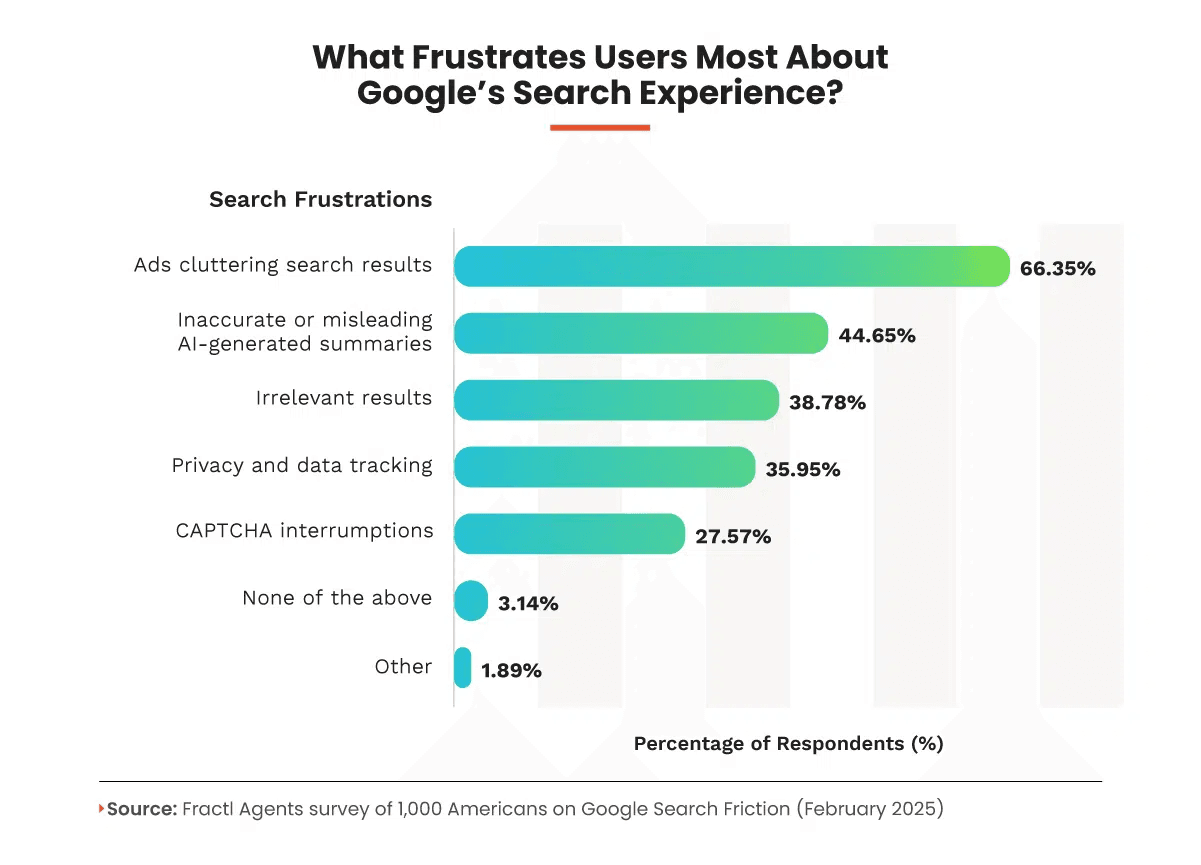
Google's monopoly on search forced us into an SEO hamster wheel. Constantly chasing algorithm changes at the expense of creating content people actually want to read.
So, what’s the alternative?
But wait, your traffic is lying to you
The uncomfortable truth most marketers aren't facing is: visibility doesn't always mean direct traffic. And direct traffic doesn’t always mean business value.
Let’s be honest about the numbers we chased in SEO — they were never as valuable as we pretended.
Most visitors didn't convert, but we justified chasing those numbers by calling it "awareness" or "top-of-funnel activity."
Which also made sense to me.
But the new reality is more complex: AI chatbots and social platforms are now creating awareness without sending you visits.
Your brand gets discovered, remembered, and mentioned, but your Google Analytics will often show nothing.
Consider these scenarios playing out thousands of times daily:
- Someone searches for information in your niche. Your site ranks in the top 3 results, but the user gets their answer from ChatGPT, which cites your content without sending you traffic.
- They also see practical content about your products on LinkedIn: They engage, maybe even save the post, but don’t necessarily head directly to your site (and I mean, just like Google these days, LinkedIn prefers it to be this way).
- Your branded search traffic increases: Not due to the traditional search behavior, but because people saw you mentioned in an AI response or social conversation and looked you up directly later.
This is the measurement gap all marketers should understand: traffic ≠ the only value in 2025.
The new playbook: Beyond rankings and traffic
SEO and marketing success now combines three dimensions:
- Discoverability: being found across platforms
- Trust: being seen as authoritative
- Brand stickiness: being remembered after that first encounter
The old SEO playbook was simple: find keyword gaps, optimize content, then wait for Google to see it.
Today's approach demands more.
Now we also need to design content to be cited, linked, reused, and digestible by AI and shared by people on social media. It also has to be deeper than what any LLM can produce in seconds.
In other words, its originality and value take priority over everything else.
Don’t get me wrong, though.
Google still matters enormously, but it's no longer your only visibility channel.
You need to amplify your brand signals across multiple channels simultaneously, creating recognition waves that build upon each other.
“Google still matters enormously, but it's no longer your only visibility channel. You need to amplify your brand signals across multiple channels simultaneously, creating recognition waves that build upon each other.”
This way, users encounter your expertise across different contexts until familiarity turns into trust.
For example, it took multiple touchpoints and various channels for me to decide I wanted to use Synthesia (an AI video generator).
I’ve seen various blog posts mention the tool, explored their video templates, and then decided to give it a go after my LinkedIn feed got flooded with news about their Series D funding.
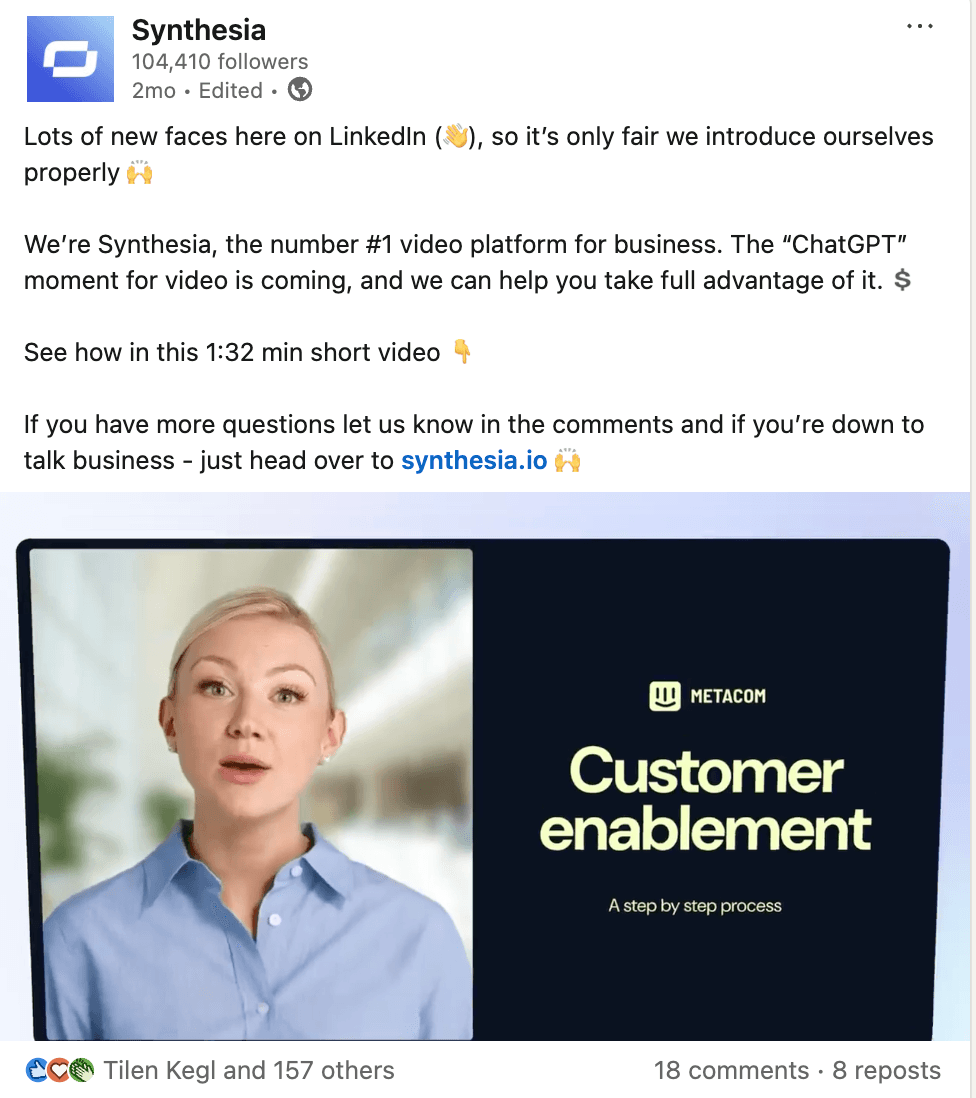
Most SEO content fails to achieve this resonance, not because it's technically wrong, but because it's forgettable.
It satisfies algorithms but creates no lasting impression that could echo across other channels and generate momentum.
So what's the solution?
Combine traditional SEO with thought leadership, digital PR, product content, and strategies that build branded search demand.
Each channel reinforces your signal in the others, creating a stronger overall presence.
“Combine traditional SEO with thought leadership, digital PR, product content, and strategies that build branded search demand.”
How to implement this approach
By focusing on creating resonance rather than just chasing rankings, we're naturally prioritizing quality over quantity.
The rules of visibility are changing, too.
Newcomers and smaller businesses can now have a shot at competing with bigger guys.
For example, Semrush’s research showed that ChatGPT tends to surface smaller domains in its results compared to Google and Bing:
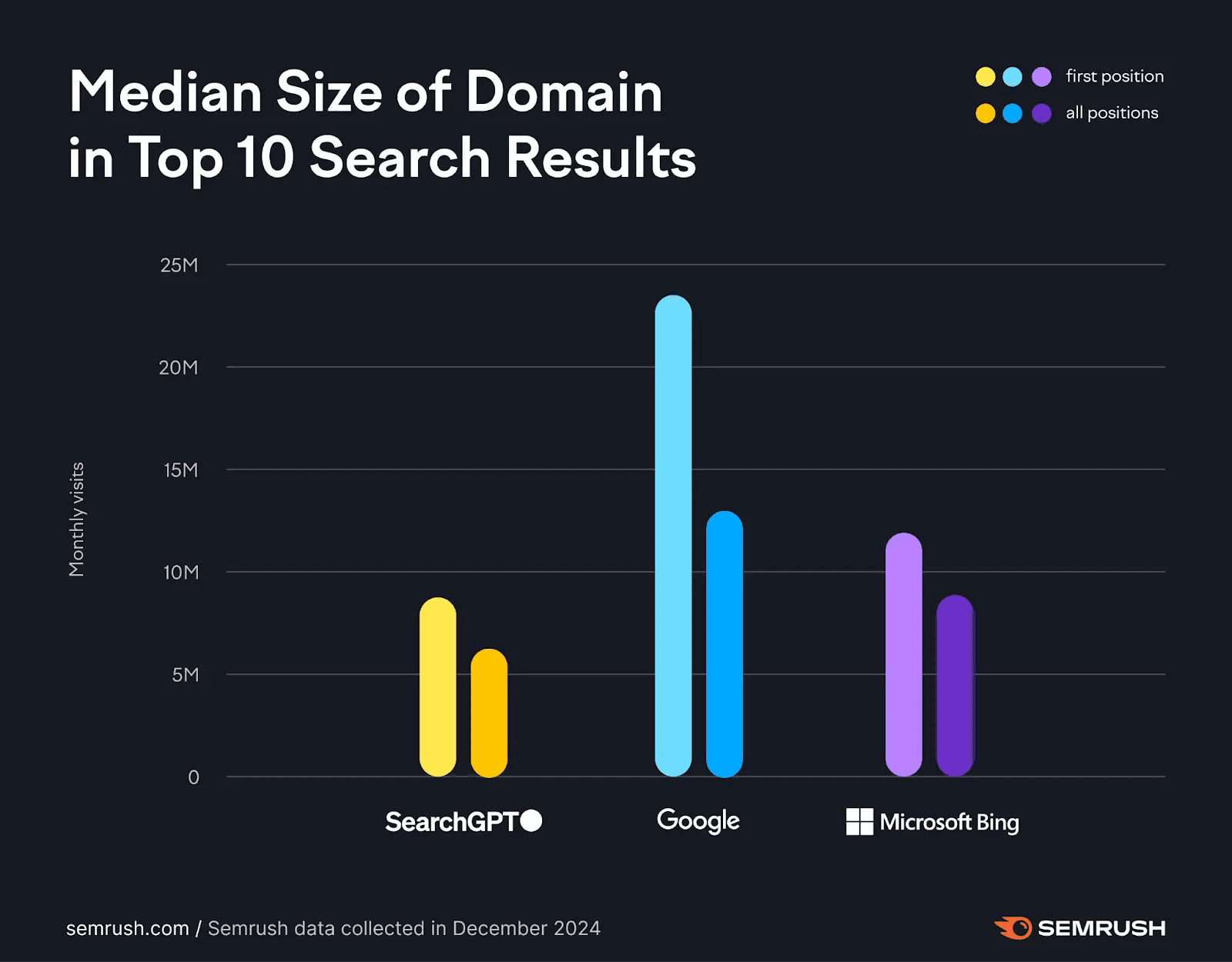
Now, let’s move from theory to practice. Here’s how to build your new SEO engine — based on what I see working for my projects and for brands that lead the way in 2025:
Step 1: Reevaluate your traffic sources and attribution
Analytic tools only show a fraction of your content's true impact. To address this, look beyond GA4 and direct conversions to understand your content's full value.
In 2025, much of your content's influence happens off-site and off-screen as "dark influence.” For example:
- Mentions in ChatGPT, Gemini, and Perplexity that create brand recognition
- Shares in Slack threads or Notion workspaces without proper attribution
- Discussions in Reddit threads or newsletters that drive delayed direct visits
- Employee social posts that influence future purchase decisions
To track this hidden impact, you can:
Monitor off-site citations with media monitoring tools like Brand24, Mention, or BuzzSumo to catch references on social platforms, newsletters, podcasts, and videos.
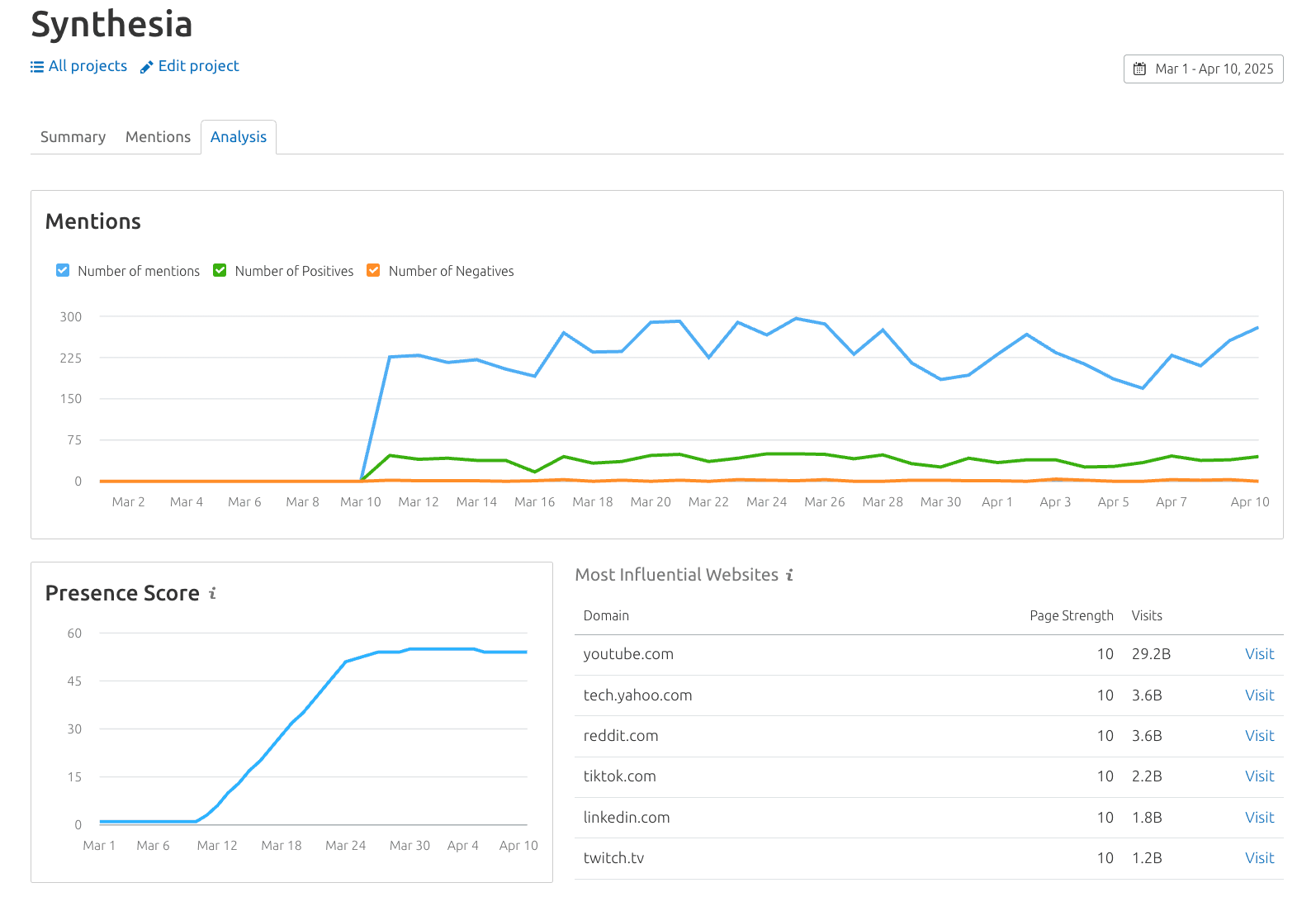
Track your AI visibility using tools like Semrush's AI Toolkit and the ChatGPT Search feature in the Position Tracking tool to see how often you appear in AI responses and which topics trigger your mentions.
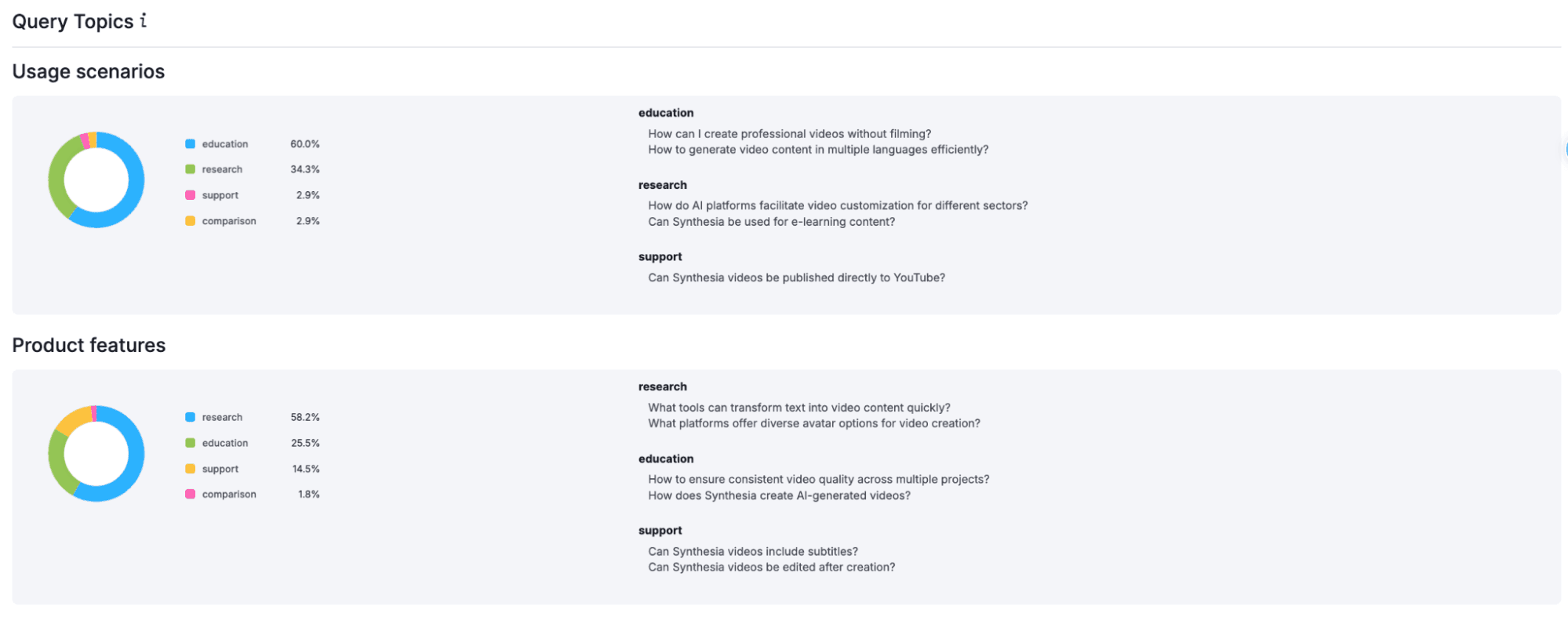
Spot hidden social mentions with search operators like site:reddit.com "yourdomain.com" and cross-reference with your analytics to identify influential content that doesn't directly drive traffic.
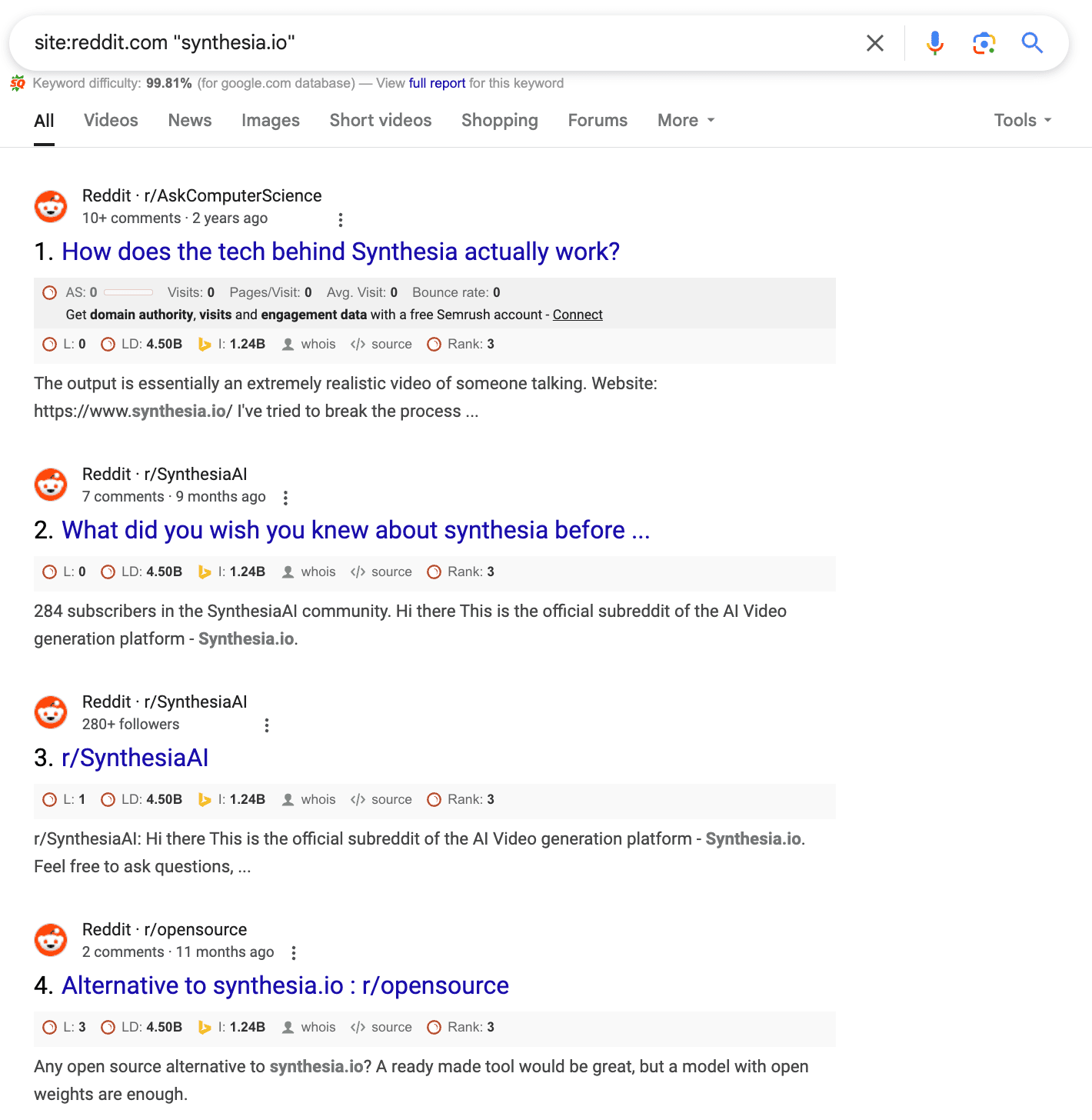
Gather team intelligence by asking sales and customer success specialists what content prospects mention, what links customer support shares most, and which posts generate DMs for your leadership team.
From here, try reframing your ROI model from “conversion” to “contribution.”
This requires a fundamental shift in how you measure content value. Instead of only tracking direct conversions, you need a system that captures content's broader influence:
- Create a lightweight tracking system to document:
- Assisted conversions by content type: Identify which pieces appear early in successful customer journeys
- Branded search volume growth over time: Monitor increases in brand name searches as a sign of awareness
- Anecdotal mentions from prospects and customers: Log the specific content or resources they bring up in sales and CSM conversations.
2. Then, assign a contribution value to the content that:
- Primes users for future decisions, even if they don't convert immediately
- Builds credibility and trust before pricing or sales conversations happen
- Creates brand recall in channels you can't always directly measure (Slack, DMs, AI tools, etc.)
Finally, surface these high-value assets to your team.
Make them aware of which content pieces influence decisions disproportionately, even without direct traffic and conversions.
Then, prioritize, repurpose, and use these assets as models for future content.
Step 2: Build retrievable, original content
If ChatGPT can generate your blog post in seconds, your audience doesn't need it anymore. They can get that same shallow information directly from AI.
Top-of-funnel content is more crowded than ever, not because it's inherently valuable but because it's the easiest to mass-produce with AI.
Generic "what is" and "how to" articles are being created even more than before, with diminishing returns for everyone involved.
Your competitive advantage now lies in what AI can't fake: implementation details, nuanced perspectives, and real-world tradeoffs.
“Your competitive advantage now lies in what AI can't fake: implementation details, nuanced perspectives, and real-world tradeoffs.”
In other words, our all-time favorite: original content.

I've noticed this pattern in my own and others’ work.
Looking at what consistently performs well (including Google rankings), it's clear that these pages share one common trait: original insights that can't be generated algorithmically.
Sometimes, it's about personal experience — sharing what you learned when implementing a strategy or the mistakes your team made along the way.
For example, Emila Korczynska, VP of Marketing at Userpilot, often shares raw, authentic details about the company’s journey and the work her team does.
In this post, she explains how they optimized their ABM program to achieve better results, with step-by-step guidelines:
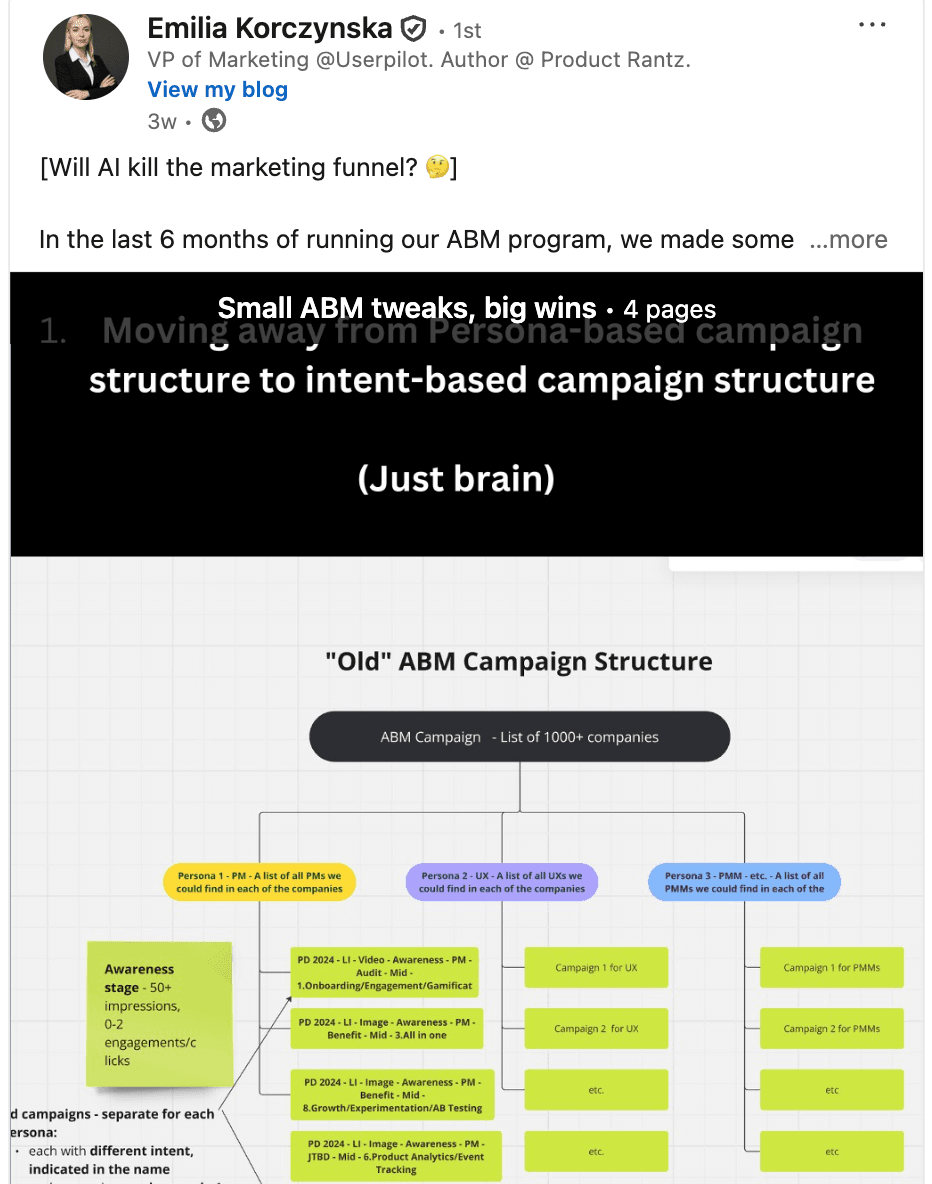
Other times, it's proprietary research nobody else has access to.
For instance, I have always loved the Conversion Benchmark Report by Unbounce.
That’s smart, research-driven content in action: using data from your own product to create content that delivers direct value and is easy for media and bloggers to cite.
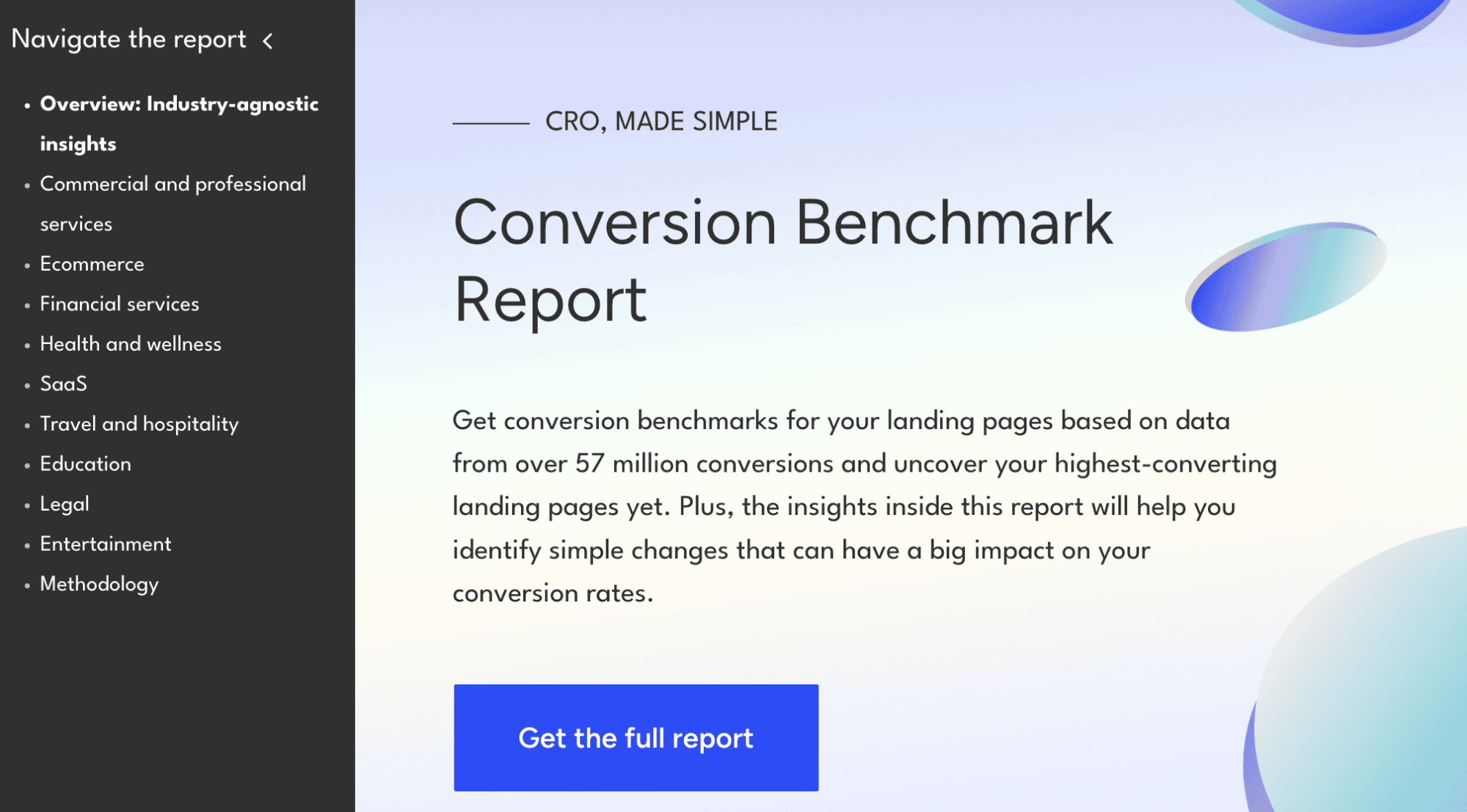
Often, it's simply a collection of fresh, carefully curated examples and case studies that haven't been endlessly recycled.
To summarize, you can create retrievable content by:
- Finding original data from your product, real-world testing, or external data analysis
- Adding situational context like "If you're a B2B team with no dedicated SDRs, here's what works instead..."
- Developing interactive tools or visual frameworks that make complex concepts tangible
- Coming up with honest comparisons that acknowledge tradeoffs rather than presenting simplistic "best" solutions
- Providing your opinions and insights on important industry developments
- Documenting authentic experiences, including failures and the decisions that followed
Another example I love is the content published by Andy Crestodina’s Orbit Media Studio.
Every piece is rooted in what Andy and his team actually learn and apply in their work.
For instance, this article on growing a LinkedIn newsletter? It’s actually based on Andy’s real-world experience with his own newsletter.
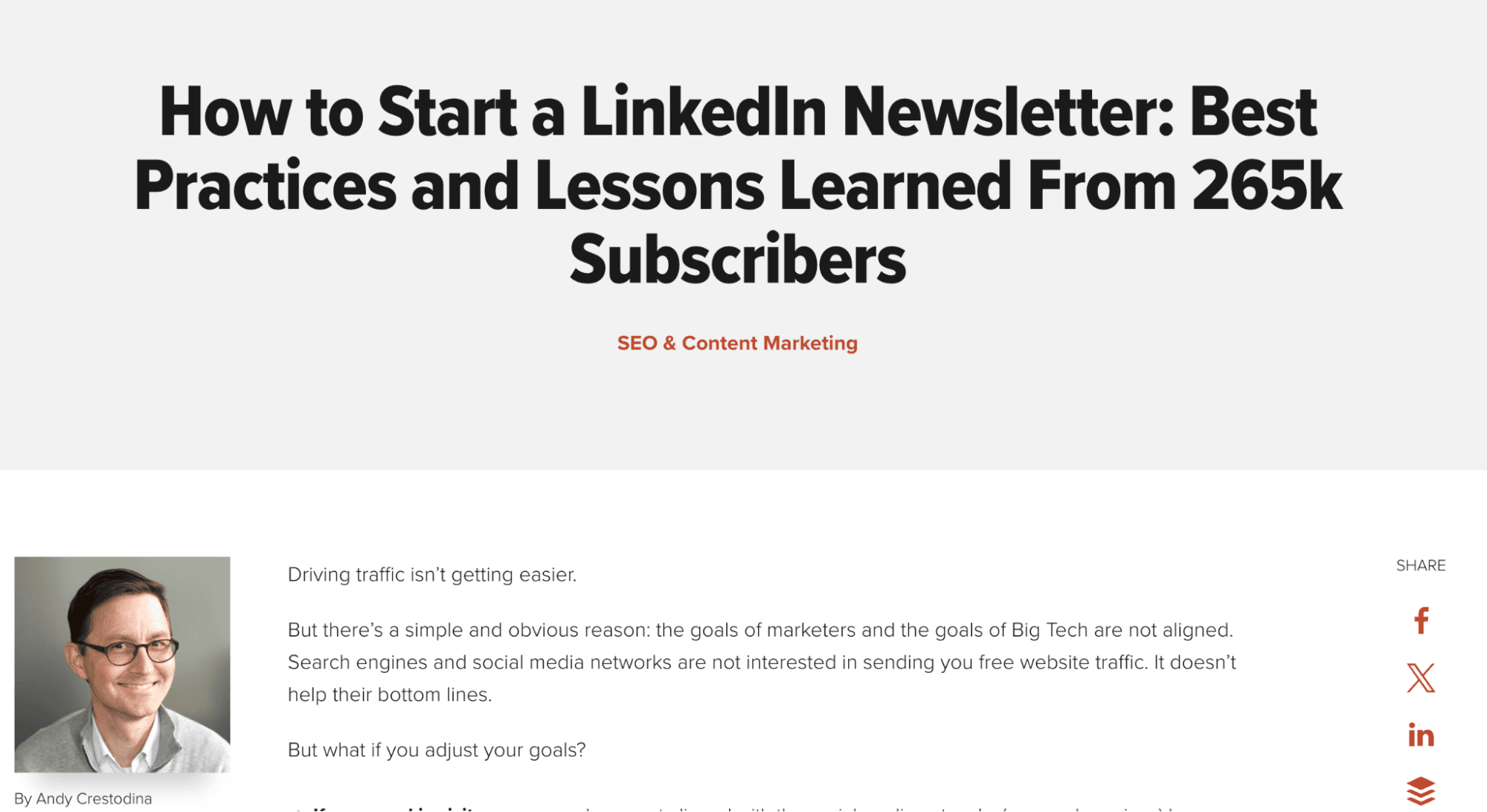
Step 3: Identify SME knowledge and convert it into content
Your business has a goldmine of original content that no competitor can replicate: the knowledge and experience of your subject matter experts (SMEs).
This approach does double duty for SEO. It creates original content that performs well in search and builds thought leadership that attracts natural backlinks and mentions.
For instance, dozens of Semrush employees actively work on building their personal brands on LinkedIn. And it directly supports our content marketing campaigns.
Many of my colleagues shared the recent research I published to promote our AI writing tools.
Some of these posts got hundreds of likes and dozens of comments, helping us spread the word organically.
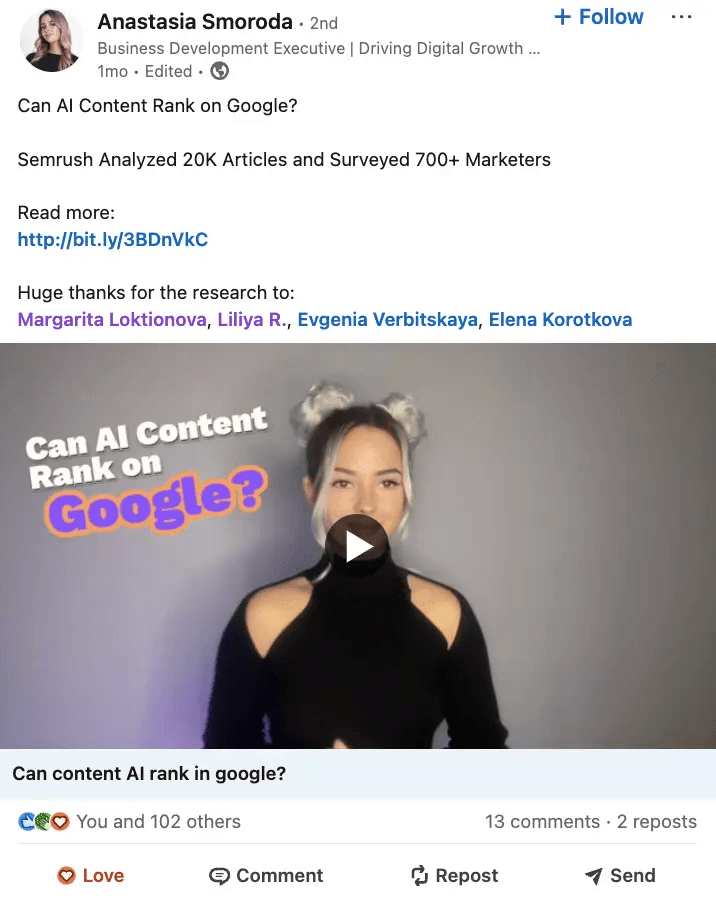
The challenge is getting this expertise out of your team's heads and into content formats that can be discovered and shared.
Here's how:
Start by interviewing your internal experts about what they've personally experienced.
The most valuable insights often come from product stories, failures they've overcome, and behind-the-scenes decisions. These real-world scenarios provide the nuance and authenticity your customers are looking for.
For instance, this article by Intercom’s Design Group Manager dives deep into what their team learned when building their own bot — an expert insight no one can replicate.
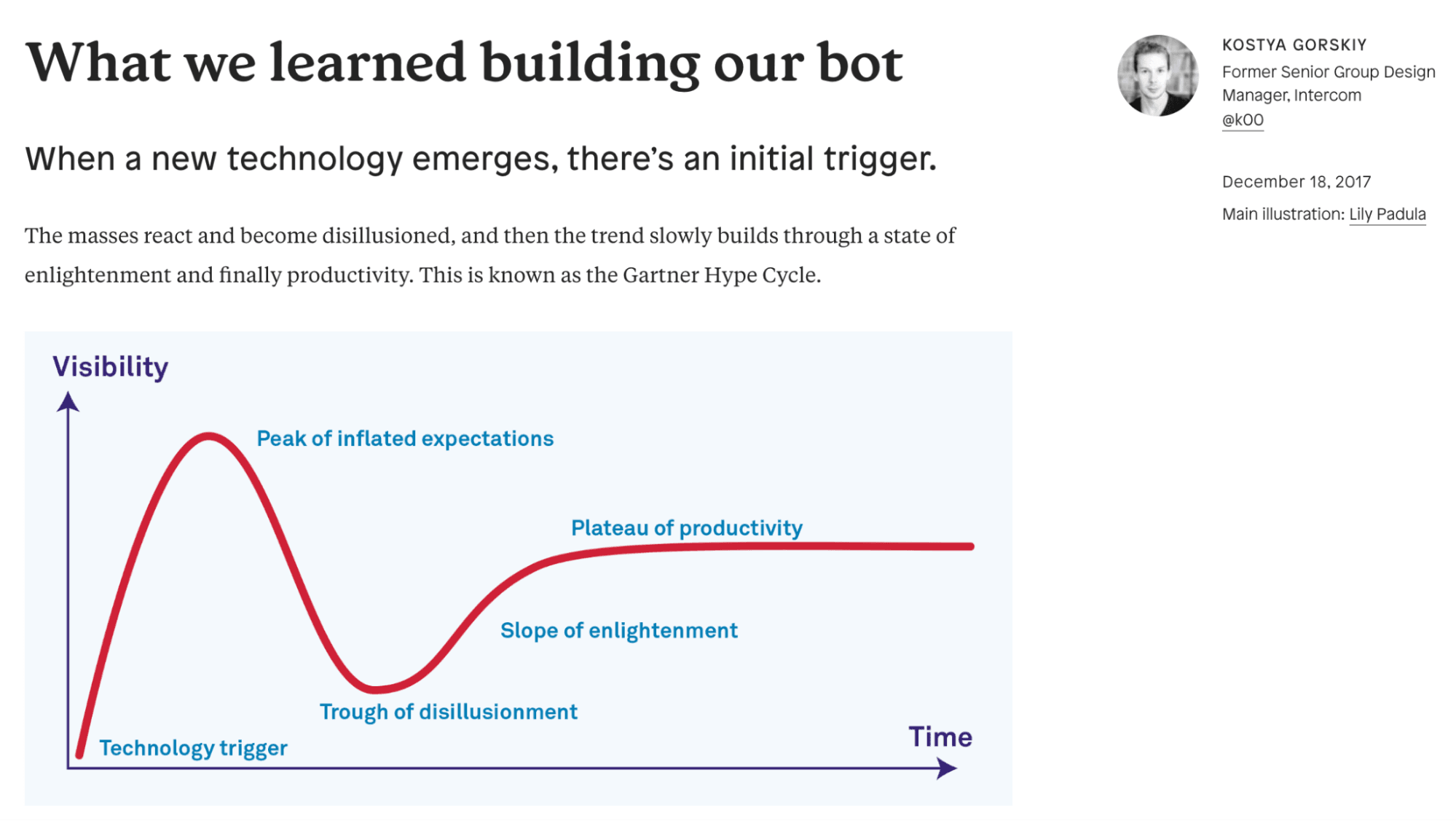
To collect such insights, keep track of everyday communication in your company.
Slack messages where team members solve problems, meeting notes capturing decision points, and customer chat logs contain valuable information in a raw form. All these can become articles, quotable insights, visual frameworks, or interactive tools.
Then, set up an ongoing process:
- Encourage your SMEs and executives to share their unfiltered opinions and experiences by securing speaking opportunities and interviewing them creating content
- Make it easy for busy experts to contribute by pre-writing prompts or creating text drafts and visual content they can use — for example, by building a custom GPT for writing LinkedIn posts faster and creating Canva templates
- Feature these insights across multiple channels: blog posts, social content, podcast appearances, and speaking opportunities
- Use content operations tools like Relato to streamline the process of capturing, editing, and distributing expertise
Step 4: Optimize for LLM visibility
LLMs are becoming important trust-building channels that influence buying decisions.
But here's what's surprising: they're also turning into legitimate traffic sources.
According to Semrush's analysis of over 80 million clickstream records, ChatGPT now refers users to more than 30,000 unique domains daily.
What's even more striking is that 70% of these prompts don't match traditional search intent patterns we're familiar with from Google.
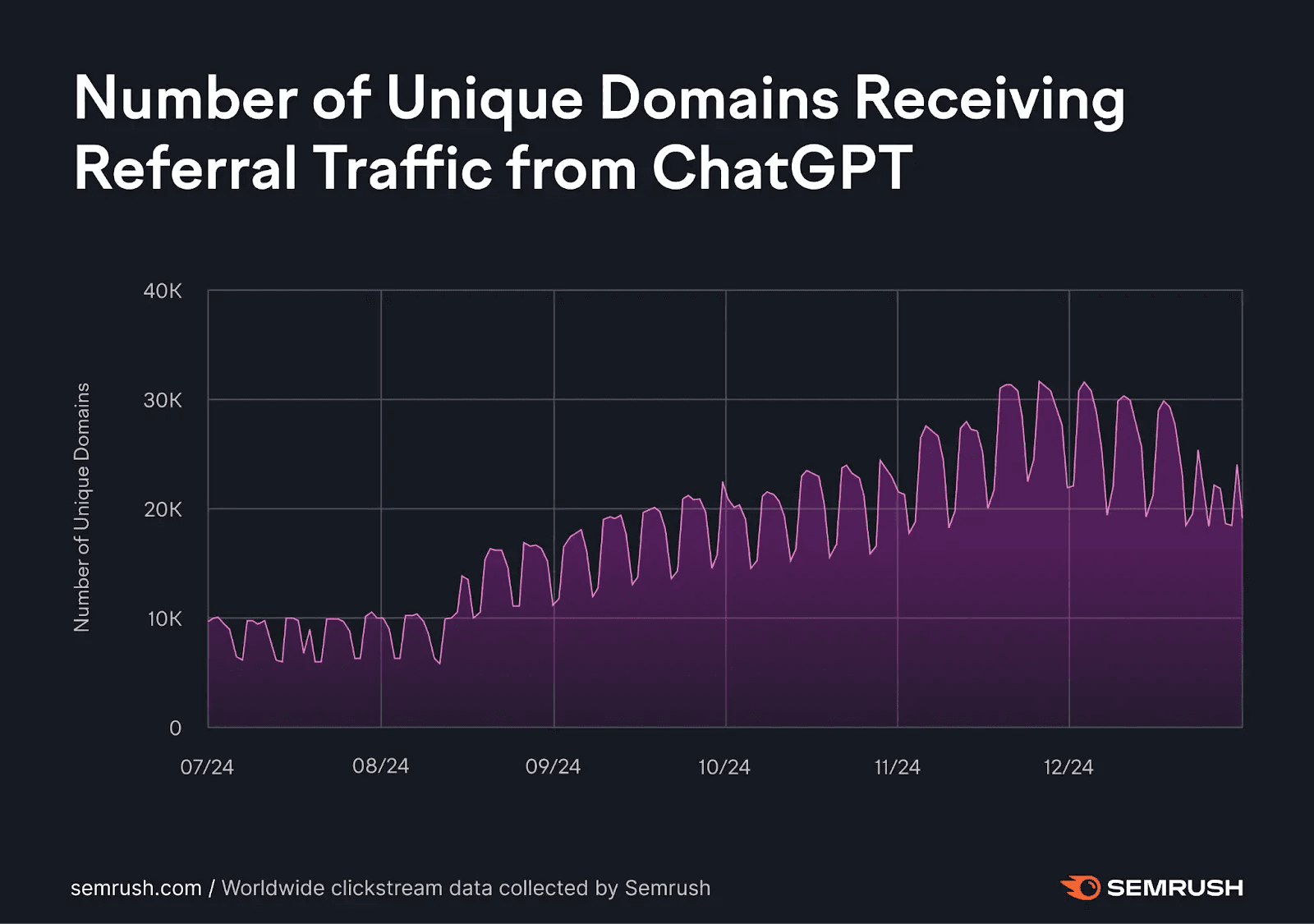
People are discovering brands through entirely new conversational pathways. And increasingly, those pathways don’t just reference your content, they can now act on it.
It’s been reported that code found in ChatGPT’s production assets included buy_now, shipping fields, and a shopify_checkout_url — suggesting OpenAI is building a native shopping flow directly into the chat interface.
In this context, being cited in LLMs also means becoming part of the transaction flow itself.
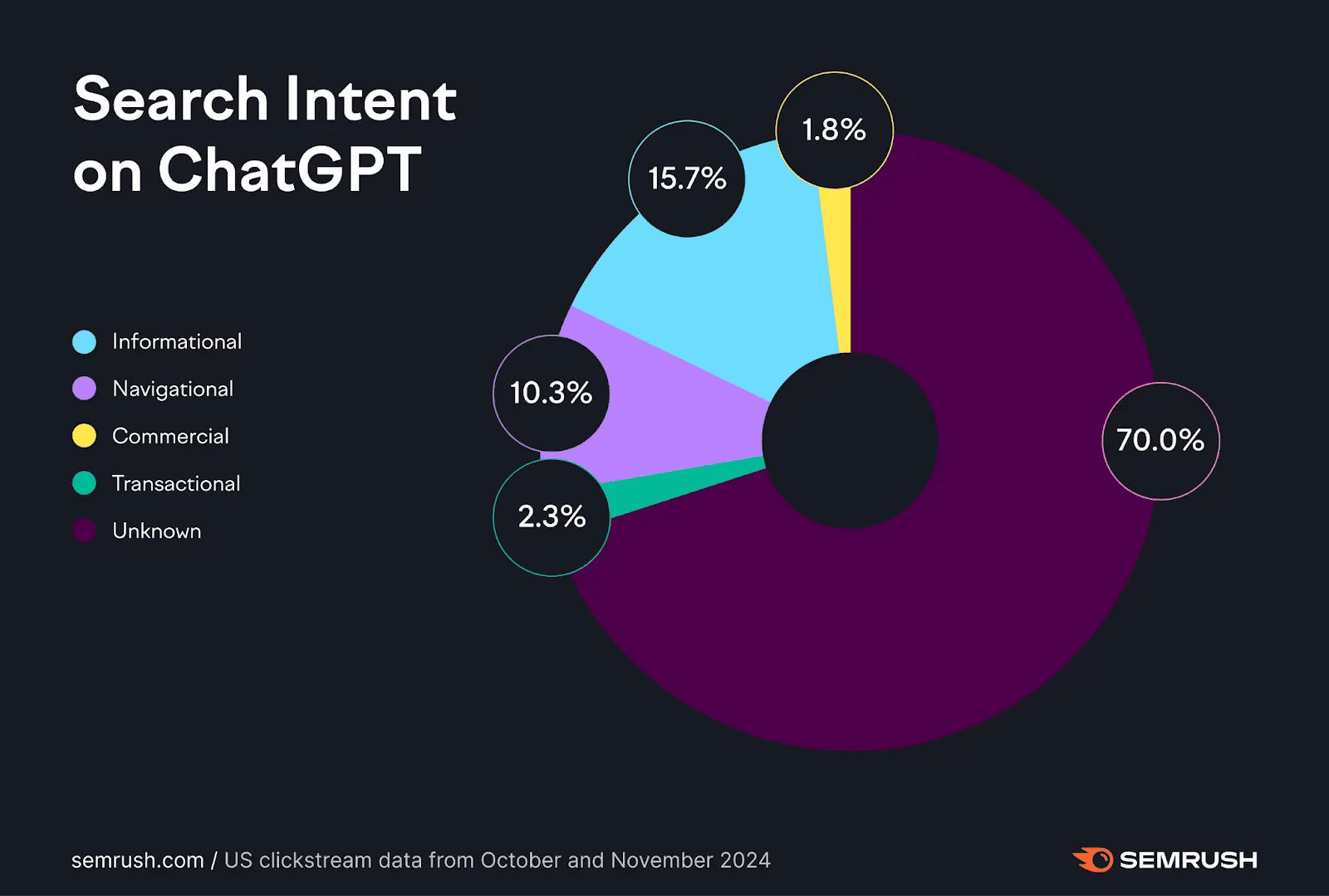
Another benefit of getting featured by LLM revolves around brand awareness.
When LLMs consistently cite your content and mention your business, you're building passive brand recognition at scale.
Users may not click through immediately, but you're establishing authority that pays dividends for your entire marketing ecosystem.
And while visibility in LLMs isn’t entirely within your control, there are a few ways to increase the likelihood of being retrieved and cited. Many of which are similar to traditional SEO tactics.
For example:
Structure your content for easy retrieval
Use clear, descriptive H2 and H3 headers that frame key points.
Include direct answers to common questions, preferably in the first sentence after a header.

Following the same logic, create FAQ blocks that directly address the questions your audience asks.
The question/answer format is particularly LLM-friendly since it maps cleanly to conversation-based interactions.
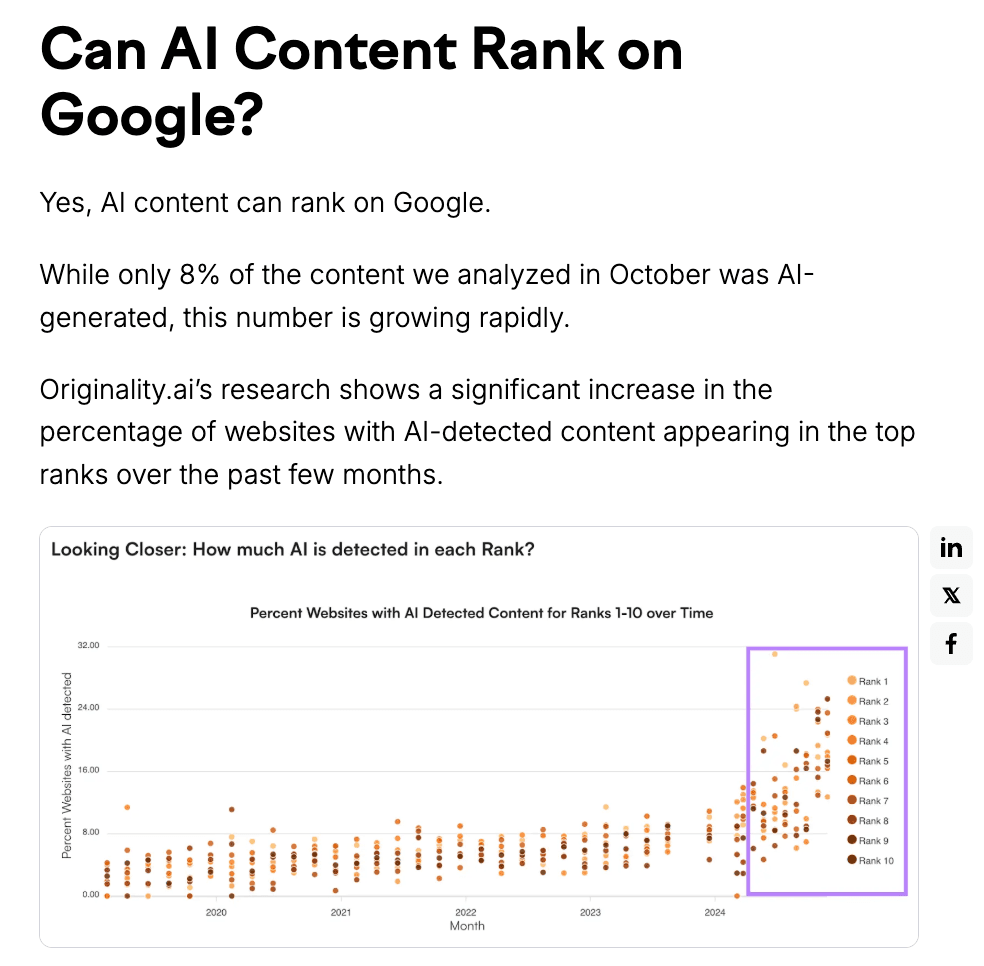
Write with quote-friendliness in mind
Create "quotable moments" in your content — concise, insight-rich sentences that summarize key points.
For example:
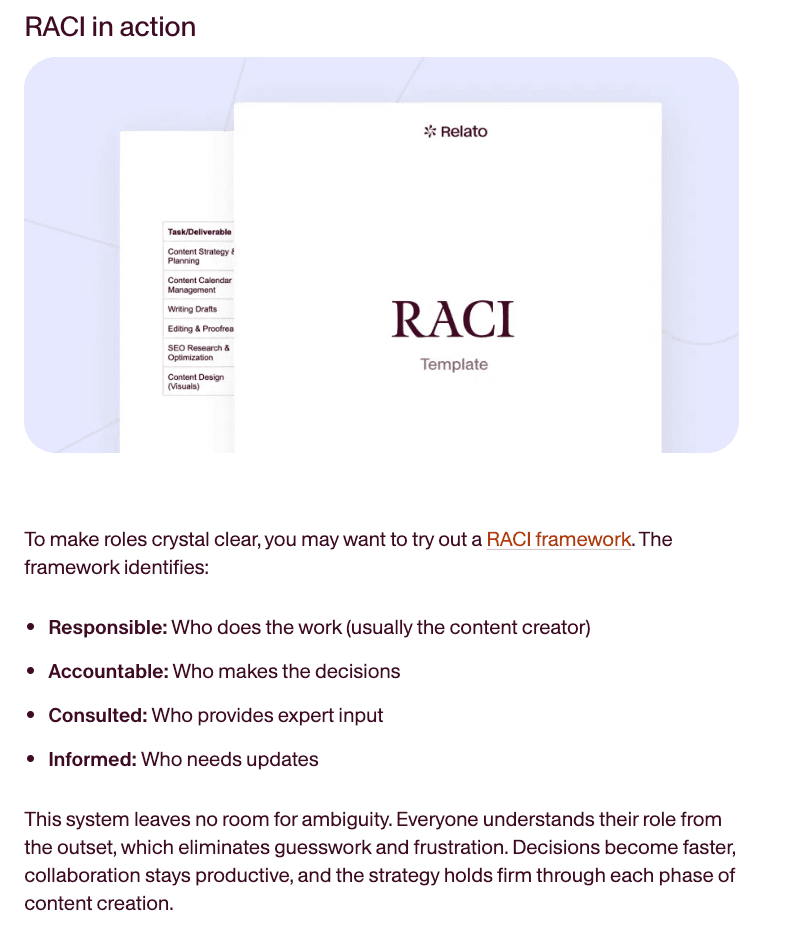
Source: Relato article
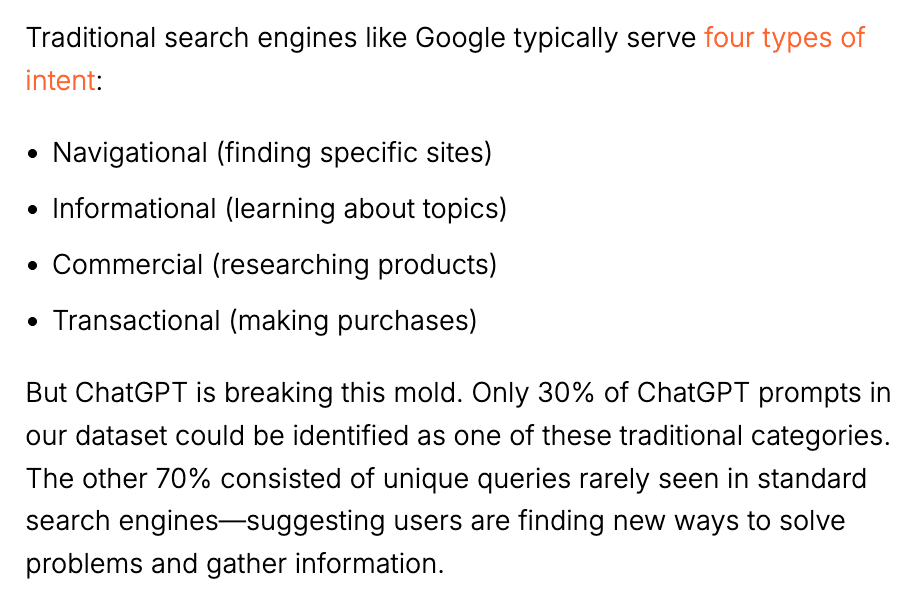
Feature unique expertise prominently
LLMs are becoming better at recognizing and citing specific expertise instead of blending generic information.
In fact, adding relevant statistics, quotations, and citations can boost content visibility in generative engines by up to 40%.
In other words: Yes, original research, expert insights, and first-hand experience fuel both SEO and GEO (generative engine optimization). But it becomes even more important with LLMs.
For instance, the first resource Perplexity pulled for my question about Core Web Vitals was an article featuring data from Backlinko's proprietary research:
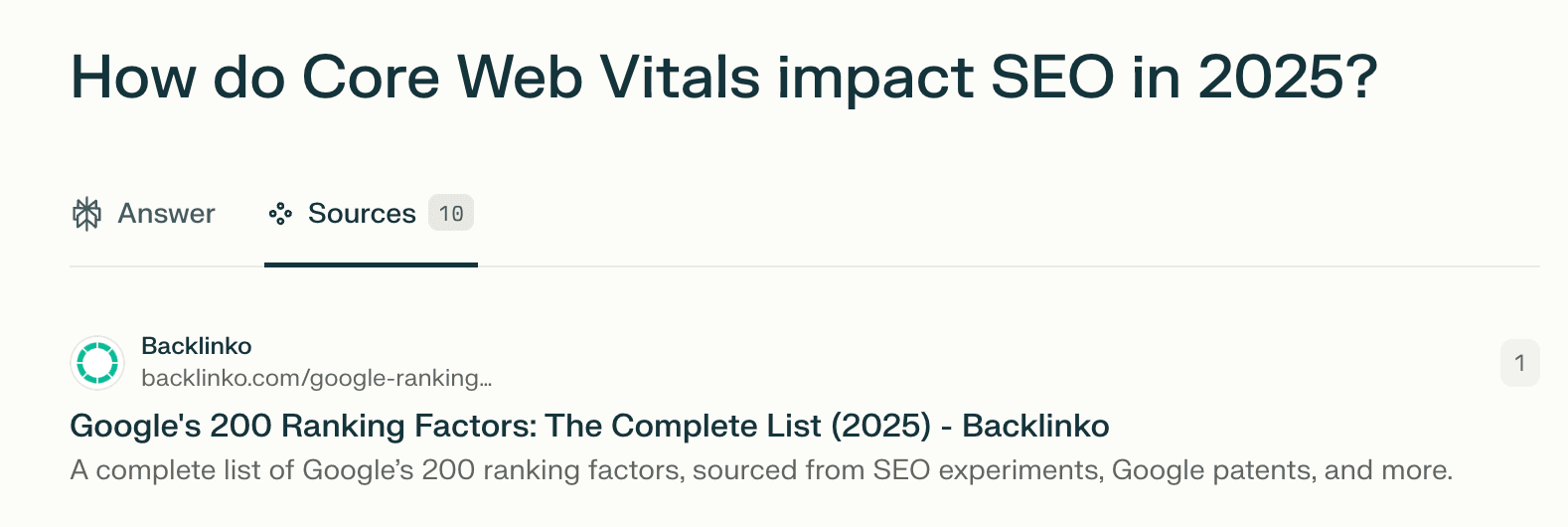
Keep content factually current and fresh
LLMs using RAG (Retrieval-Augmented Generation) — like GPT-4 and Claude — can pull in the most up-to-date information at query time. This makes their responses more accurate and relevant, even as facts change.
So, regularly updating key pages with fresh content helps position your site as a trusted source.
We’re seeing a similar trend with Google’s AI Overviews, which tend to favor recently updated content. Especially for dynamic topics such as technology, finance, and health.
For example, a study found that Google’s AI Overviews are much more likely to cite content that has been updated within the past 30 days.
How does it compare to traditional SEO?
In SEO, content freshness affects rankings mainly for queries where recency matters, like trending news or product launches. Google's "Query Deserves Freshness" (QDF) algorithm identifies such queries and prioritizes newer content accordingly.
However, for evergreen topics, the freshness of content is less critical in SEO rankings.
Implement proper schema markup wherever possible
While it's still unclear exactly how LLMs use this technical markup, there's growing evidence that structured data helps these systems understand your content's meaning and authority.
Schema markup is a type of code you add to your pages that tells search engines (and potentially LLMs) what your content is about. Like whether it's a product, article, recipe, or FAQ.
For example, Microsoft confirmed using schema markup to help its LLMs learn and understand.
Step 5: Run visibility-building campaigns
Mentions drive memory. And memory drives traffic.
If you're still chasing backlinks like it’s 2015, you’re missing the bigger picture.
Today, your PR strategy should aim for citations, not just links.
Yes, backlinks still help traditional SEO.
But brand mentions in high-authority spaces do even more. They tell both readers and LLMs that you’re legit.
This is where SEO, GEO, and brand-building fully converge.
Want visibility across channels? You need coordinated campaigns that earn attention everywhere.
For example, I’ve found that syndicating original research across multiple channels dramatically amplifies its impact.
The research-driven campaigns I’ve launched at Semrush — like the State of Content Marketing reports — have been performing so well thanks to the cumulative effects of repurposing content and using it to power multiple channels.
In fact, this report brought in over 100K visits and generated 18K leads.
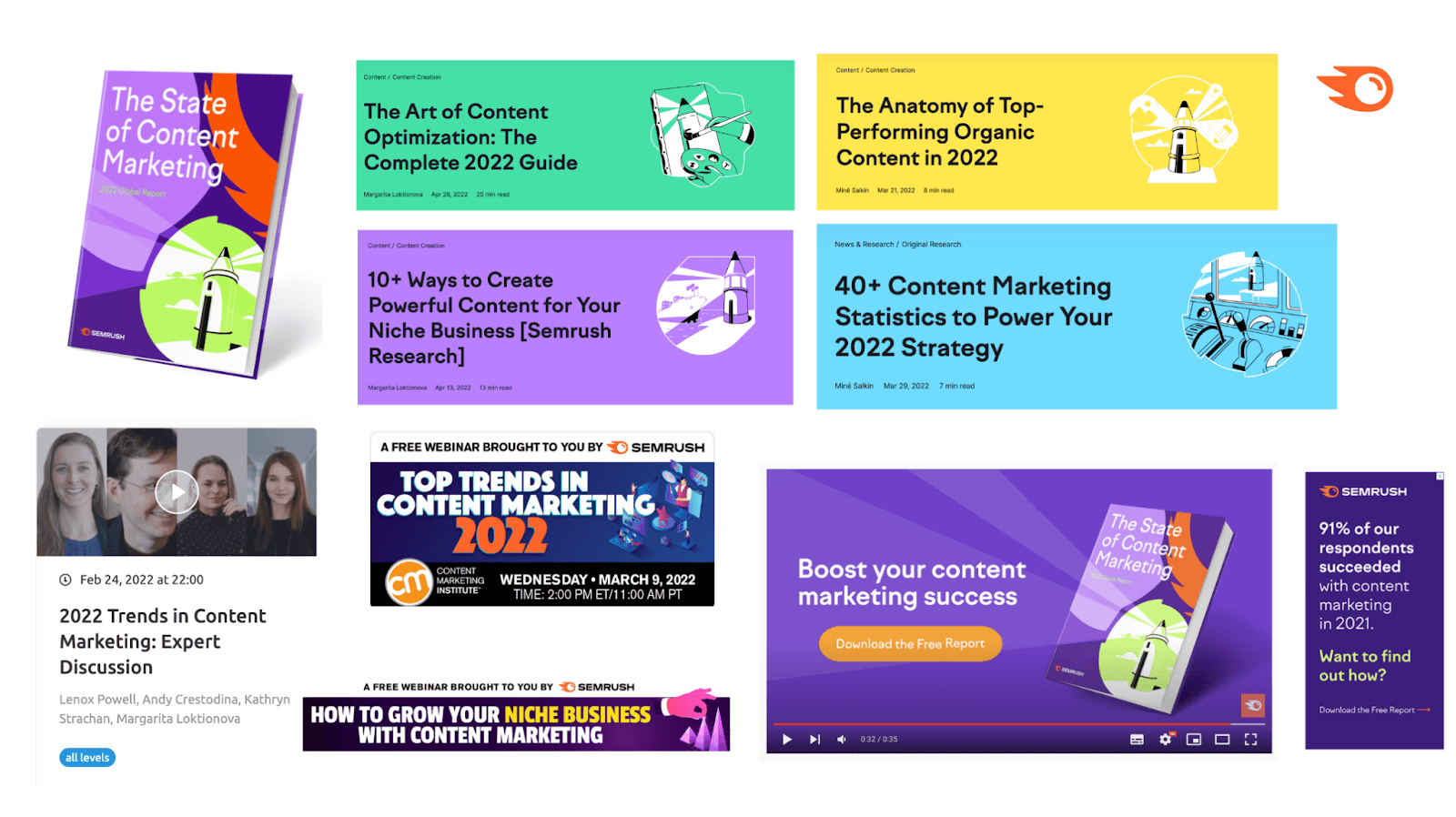
How can you achieve the same?
On top of publishing on your blog and creating a distribution plan via your newsletters and podcast interviews, here are some other tactics to use:
- Pitching your founders and SMEs to speak on niche topics and get featured in events, podcasts, and industry articles
- Developing original, citation-worthy frameworks that simplify complex concepts (think HubSpot’s Flywheel model and Gartner’s Hype Cycle)
- Running digital PR campaigns focused on data-driven stories rather than promotional messaging
- Publishing expert commentary on trending industry news that journalists can easily reference
- Building relationships with academic institutions that may cite your research
- Creating collaborative research projects with complementary brands to expand reach
For example, Dove and Nike's joint research on why teenage girls quit sports revealed body confidence was a key factor. Their collaboration merged Dove's self-esteem expertise with Nike's sports focus, creating resources that expanded both brands' reach while addressing an important issue.
Step 6: Focus on content that matches high-intent queries
Search queries are becoming more conversational.
Instead of "email marketing tools," people now search "Which email platform lets me segment abandoned cart customers by product category and location?"
Semrush research shows that ChatGPT prompts average 23 words without search enabled, compared to just 4.2 words when search is on (i.e., when users enable ChatGPT’s browsing feature).
Which contributes to this “unknown” intent type we discussed earlier.
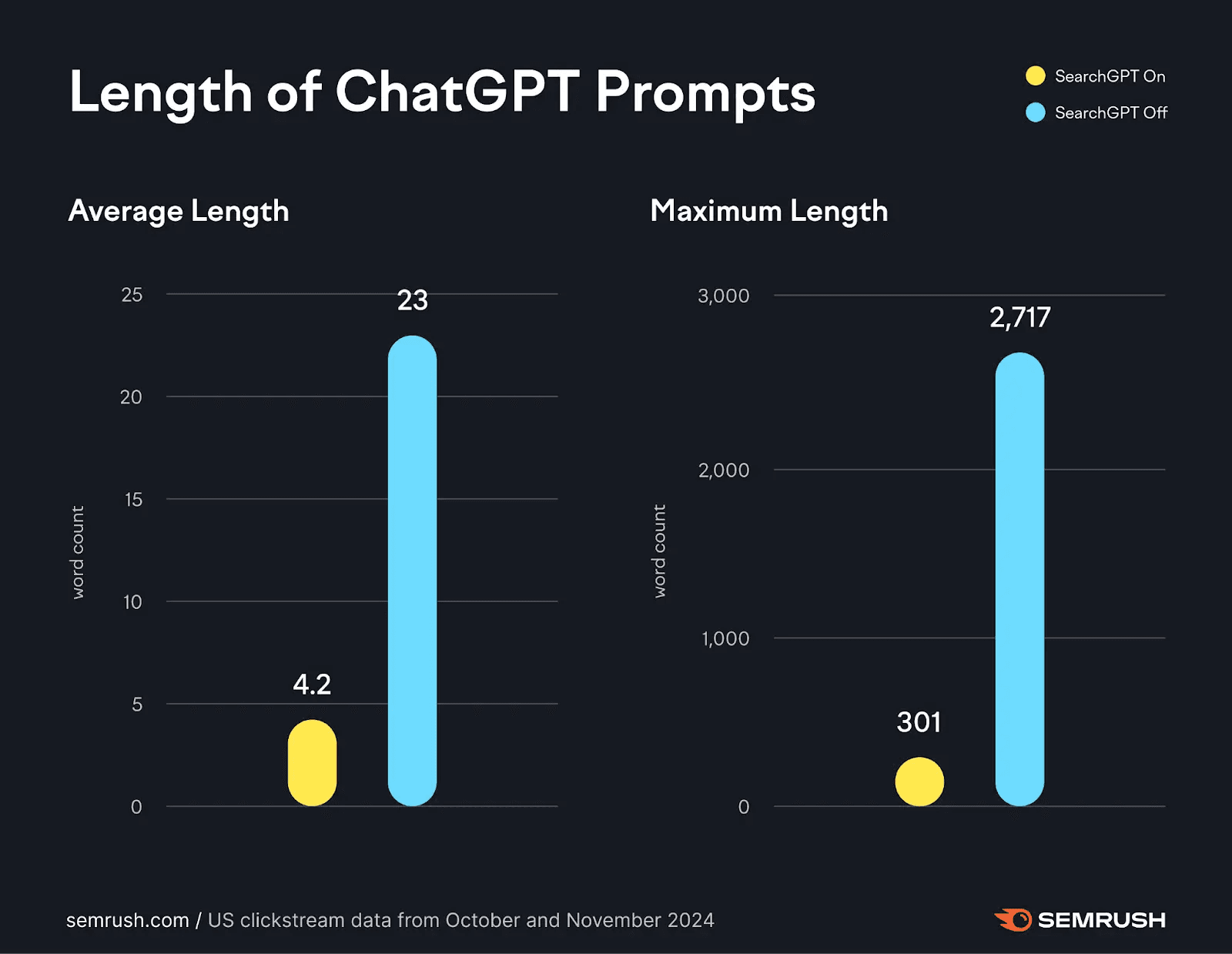
Besides, users can now get high-level answers to generic queries directly from the chatbot. No need to scroll through a 4,000-word guide.
All this means your SEO (and GEO) strategy must shift from capturing any traffic and focusing solely on keyword clusters to attracting high-intent visitors. That shift requires digging into how people actually make purchasing decisions, not just what they search, but why and when.
To achieve that, create content that directly addresses buying behavior and map it to the decision-making moments.
Think about what people ask during demo calls. What they say in Reddit threads. The objections your sales team hears over and over.
Then, use those insights to create content that mirrors how they evaluate tools. Build comparison pages, tutorials, and migration guides that answer real buying questions.
I used this strategy when launching a research report at Semrush recently.
We identified a concern users frequently raised during sales conversations, “Can AI content rank in search?” and conducted research to address it.
The result? Impressive organic reach with 1.6 million social media impressions and direct bottom-line wins.
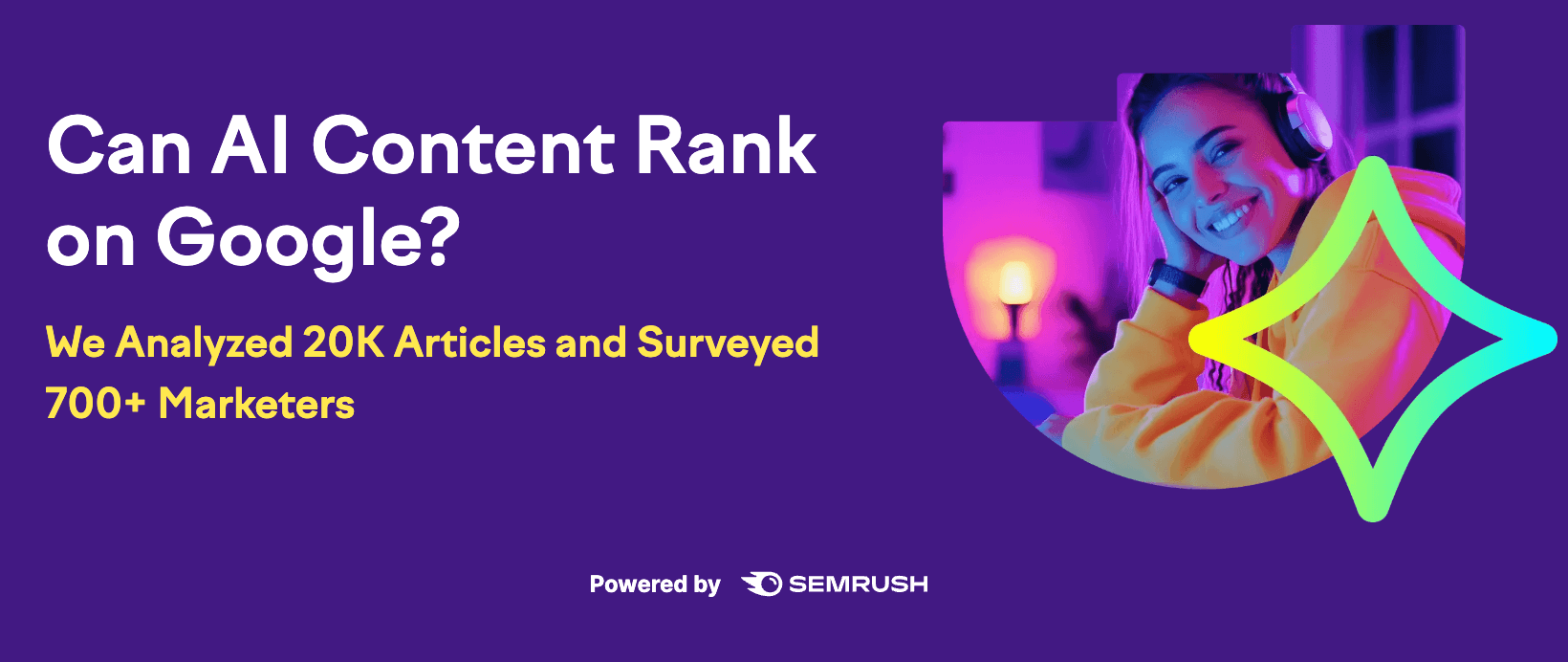
Focus on specifics — show how your product solves the problem they're actively researching.
In our case, we demonstrated how our AI writing tool helped users create content that both users and search engines would favor.
Step 7: Ship content faster without losing quality
Publishing timely content helps you build a citation history that both traditional search engines and LLMs recognize and become the go-to source for emerging topics.
But things can get messy fast, especially if your content ops are scattered across too many tools.
I’ve run into this while writing about AI. You spend weeks polishing a piece, then OpenAI drops a new feature, and your article is outdated before it even goes live.
Here’s how to avoid that — and also steer clear of the “Frankenstack”: a scattered, cobbled-together workflow of disconnected tools that slows everything down.
- Create a process for finding up-to-date insights — regularly monitor LinkedIn feeds, news sites, and industry forums, set up alerts, and assign tracking ownership
- Design SEO and content marketing SOPs to help new team members move quickly
- Reduce content bottlenecks by templatizing briefs and internal workflows
- Try a centralized content-specific tool for production management
Using Relato helps you speed up SME input, version control, and social repurposing.
First, select the pre-built comparison content workflow that already includes all the necessary tasks and approval steps.
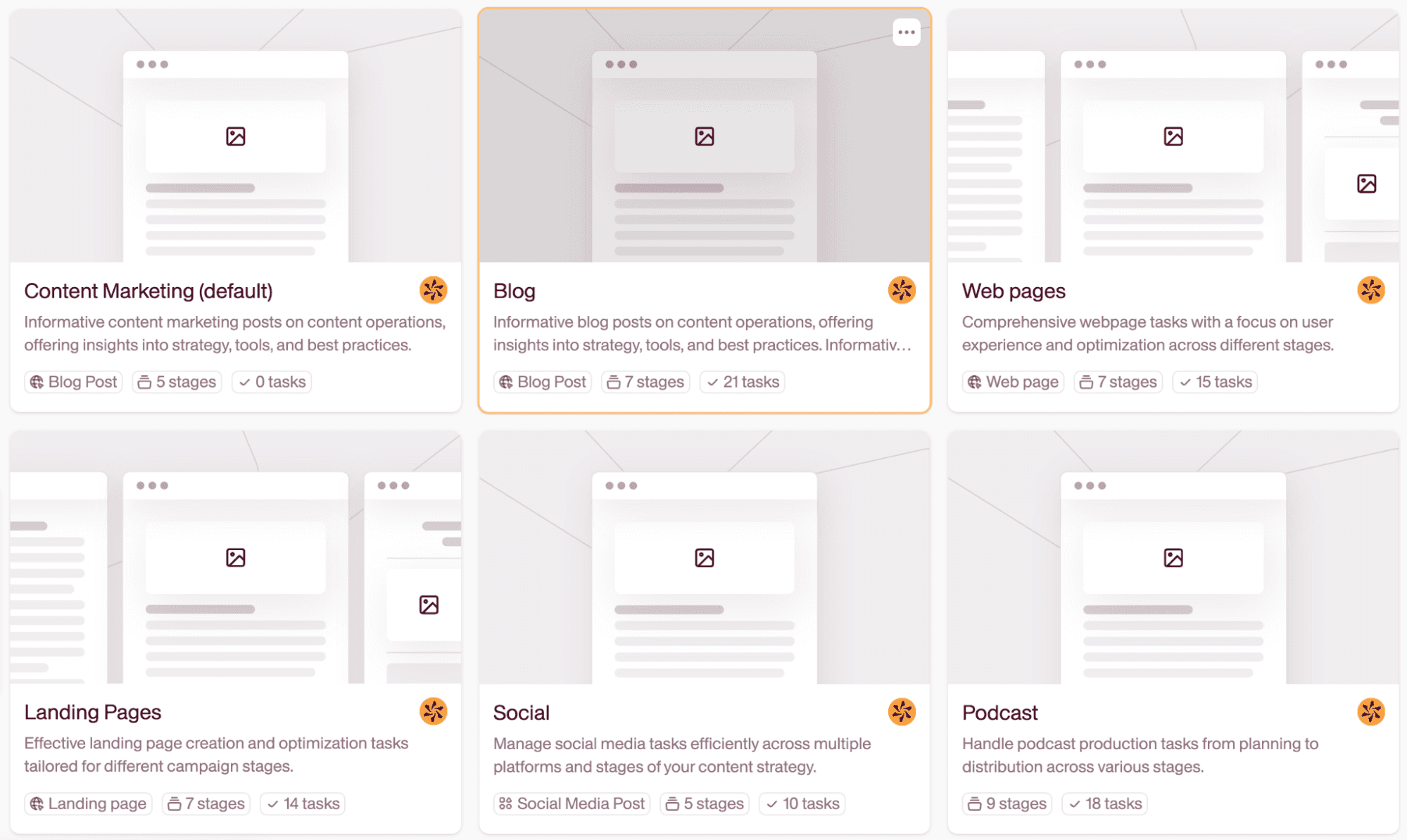
Add your team members once, and they automatically get access to every asset related to this project — no more chasing permissions or sending Google Doc links.
When your content strategist outlines the comparison structure, it's instantly available to writers, editors, and SEO specialists in the shared workspace.
And while the writer creates the draft, your SEO specialist can simultaneously work on keyword research, and designers can prepare comparison tables — all tracked in one central location.
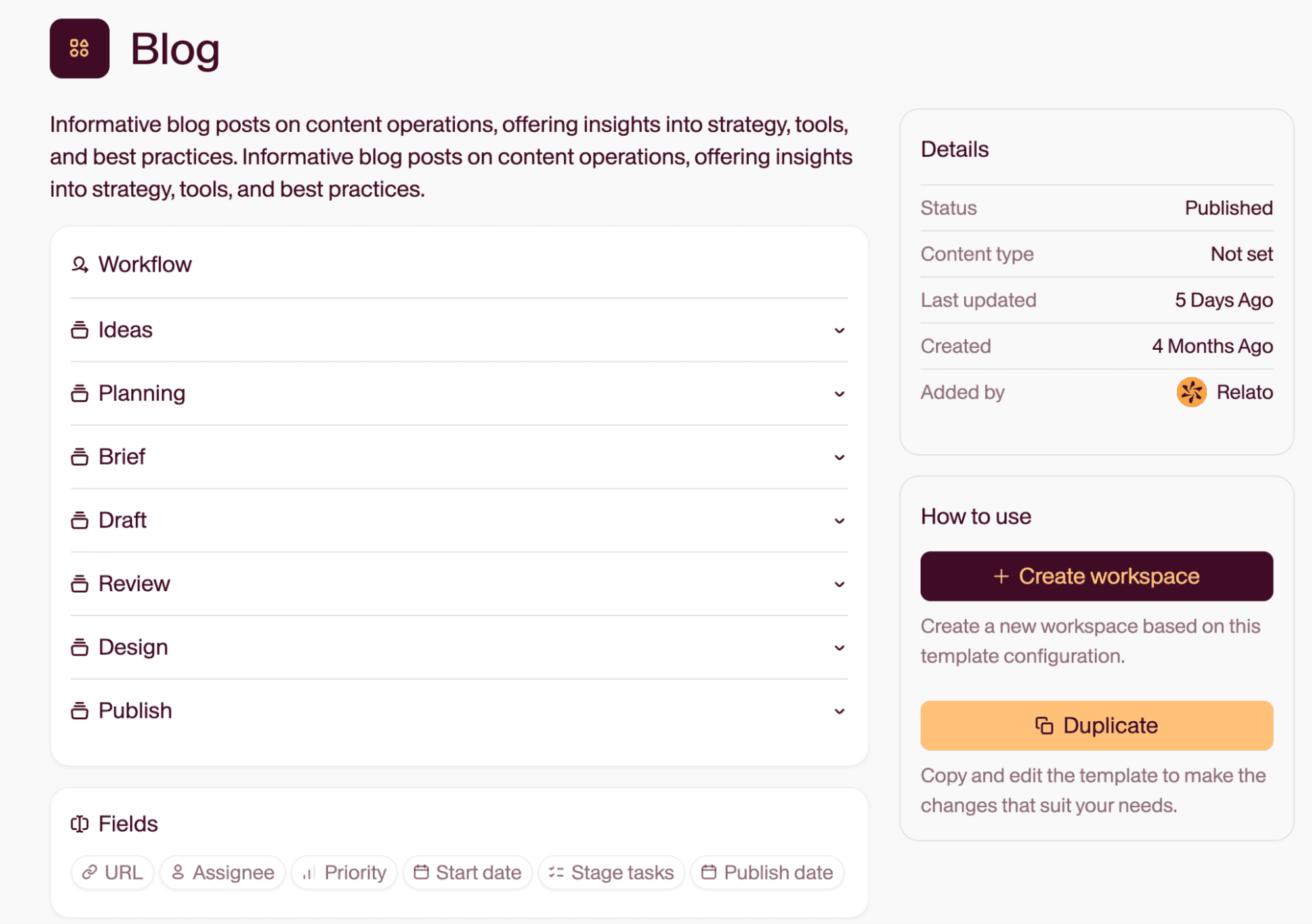
This way, you can build an SEO content engine with clearly defined elements: Image and text libraries, clear roles and deadlines, and a defined approval process.
Final take: You don’t need more content — You need more surface area
The new SEO playbook demands extending your brand's visibility beyond Google.
Build content that exists everywhere your audience makes decisions — SERPs, LLMs, communities, social media, and private channels.
Ask yourself:
If someone looks for solutions in their company Slack archives, shared Notion workspace, Reddit threads, or asks ChatGPT, would your brand get mentioned?
And would your content be the resource others share and reference in these spaces?
If not, rankings alone won't deliver the impact you need.
This new reality also needs different metrics. Try to complement:
- "Top page traffic" with retrieval moments like ChatGPT mentions, Reddit discussions, and quote pulls
- "Organic sessions" with qualified actions like demo views, saves, shares, branded search growth
- "Ranking drops" with intent satisfaction shifts (is your topic better solved elsewhere?)
Then, connect it all back to your core SEO strategy — using these new signals and channels not as replacements but as amplifiers.
Ready to turn this playbook into a repeatable system? Relato helps you move faster, stay aligned, and scale smarter.